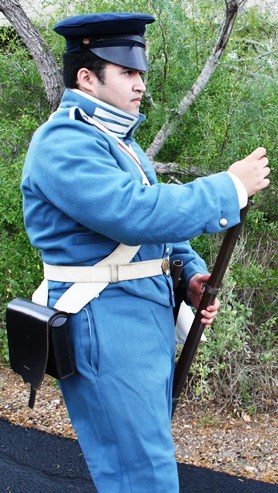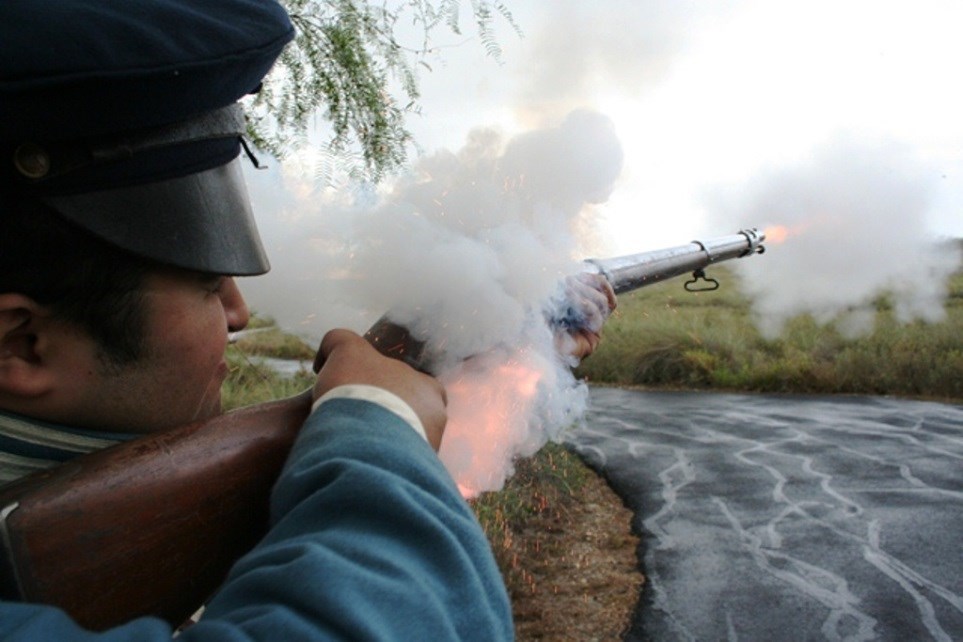
NPS What’s in a Name?Have you heard the saying lock, stock, and barrel before? It refers to the three main parts of a musket—the firing mechanism or lock, the wooden stock, and the steel barrel. During the U.S.-Mexican War, both countries sent their infantries into battle with the flintlock musket as their main weapon.Flintlocks get their name from the type of lock they use. With a squeeze of the trigger, tension on several internal parts is released. This causes a piece of flint to come crashing down onto a steel plate, creating a shower of sparks. These sparks ignite gun powder held in a shallow steel or brass pan on the side of the lock. Its simplicity made it practical to use and easy to maintain. Although newer firing mechanisms for muskets were beginning to make waves among the armies of the world, it was the trusty flintlock that saw most of the action during the U.S.-Mexican War. Load & FireLoading and firing a musket was not a quick and easy process. The weapon had to be loaded at the gun's muzzle. U.S. and Mexican armies spent countless hours training their soldiers to load and fire their muskets. The U.S. musket drill called for 12 motions and the Mexican drill called for 11 motions. Both musket drills start at the Shoulder—ARMS position. Once the instructor was satisfied with the soldier's progress, training with live rounds would being.The musket drill begins with the lock in the half-cocked position. If the lock is functioning properly, it will not fire from this position. In other words, it will not go off half-cocked. Before the musket can be fired, it must be "primed". A paper cartridge is removed from the cartridge box. The cartridge contains gunpowder and a musket ball at the bottom. The cartridge is torn open using the teeth and a small amount of the powder is then poured into the pan. 
NPS Halfway done The frizzen or steel is then brought down to "close" the pan. With the priming powder secured in the pan, the loading process can continue. While keeping the remaining contents of the cartridge secure, the cartridge is brought up to the mouth of the muzzle. The next step would be to "charge cartridge". This meant pouring the rest of the black powder, musket ball, and cartridge paper down the barrel. The charge still needs to be seated at the bottom of the barrel. This is done the ramrod. With the ramrod back in its place, the musket is brought back to the Shoulder—ARMS position. Combat situations The detailed loading process was mostly performed during the training process. In a live combat situation the soldier would be given the command LOAD and go through the entire loading process on his own. Once the musket was loaded, the soldier would remain at the Shoulder—ARMS and wait for further commands from the commanding officer. 
NPS Fire! Finally, the only thing the soldier just had to wait for was the commands to Ready—Aim—Fire! Or so you hoped so. Misfires were common when using flintlock muskets. Weather conditions could affect the priming powder in the pan. Sometimes the flint striking the steel produced no spark. Other times the sparks ignited the only the powder in the pan resulting in a flash in the pan. These were all problems a soldier was expected to address as they occurred. That’s not so easy when you’re standing in the middle of raging battle. Nevertheless, U.S. and Mexican soldiers were expected to follow their training and perform in combat situations. The flintlock musket is an unremarkable weapon. It relies on a simple mechanism to accomplish its goal. The courage it took to wield one of these weapons in battle was anything but. |
Last updated: May 17, 2024
